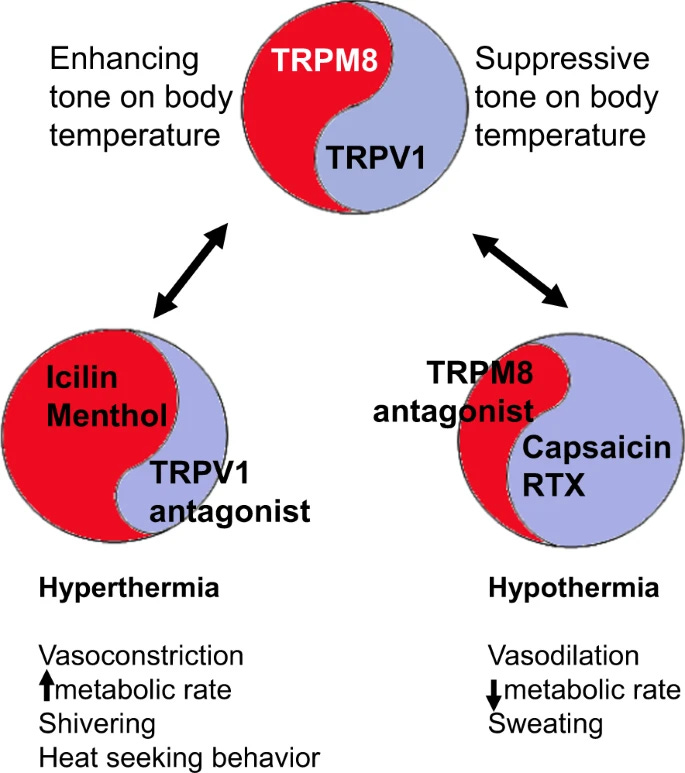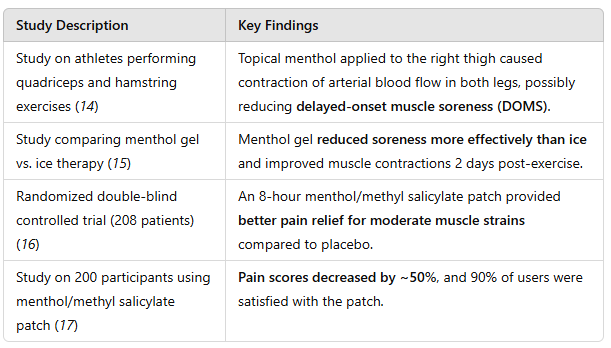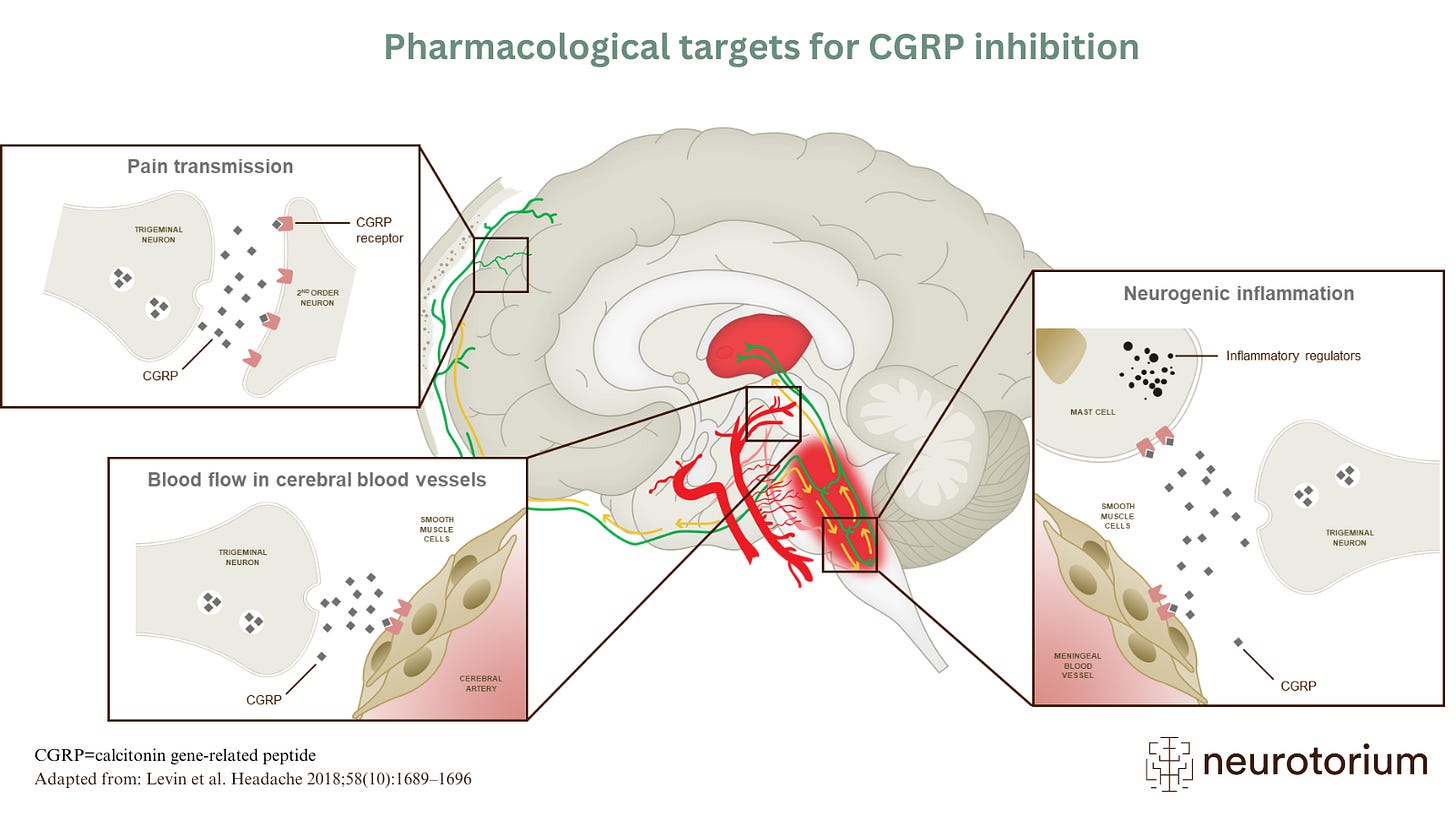📜Ancient Use
The mint plant originated in the Mediterranean and has been used in medicine💊 and food🍽️ for thousands of years. Through trade, it spread to Asia and Europe and was brought to the United States by some of the first pilgrims who landed in America. There are believed to be over 7,500 varieties of mint🌱. The Greek physician Dioscorides recorded numerous health benefits of mint and described it as a treatment for infections 🦠, hiccups 😯, breast swelling💢, dog bites 🐶, ear aches 👂, and headaches 🤕. Although most people associate mint only with its attractive cooling sensation, many cultures found exceptional medicinal benefits of mint that can be used for multiple medical issues.
🧪Relevant Biochemical Pathway
To understand how mint is able to exert its major effects on the body, we have to examine the major receptor that it works on: Transreceptor Receptor Potential Melastatin 8 or TRPM8. The implications of this receptor are so profound that the 2021 Nobel Prize 🏆 in Physiology or Medicine was awarded to David Julius and Ardem Patapoutian for their work on TRPV1 and TRPM8. (TRPV1 is the receptor activated by capsaicin 🌶️ — stay tuned for a future article on that.)
The biochemistry around TRPM8 is complex so I’m going to only highlight some of the key aspects. For those who want to get a deeper understanding of the mechanism of TRPM8, I have attached some great articles published in Nature 📰 (1,2,3).
The main function of the TRPM8 receptor is to help the body sense cold temperatures🥶. When cold wind hits our skin 🌬️, it activates TRPM8 receptors, often triggering goosebumps and shivering as the body responds to the cold stimulus. Anyone who has chewed mint gum or used mint toothpaste can attest to its characteristic cooling sensation ❄️. Mint is simply activating TRPM8, which leads to that icy, cool feeling in your mouth 👄.
Along with shivering, activation of TRPM8 on a cold day also leads to significant changes in your body including vasoconstriction (narrowing of blood vessels 🩸), increased metabolic rate , and heat-seeking behavior 🔥. The figure below is from a Nature article that depicts some of the main actions of TRPM8 (4).
Our TRPM8 receptors evolved over millions of years to protect us from the damaging effects of excess cold🧊. Vasoconstriction of certain blood vessels can shunt blood 🩸internally to our major organs. This is depicted in the figure below (5), where mint activates TRPM8 leading to changes in intracellular calcium stores and contraction of smooth muscle 💪 around blood vessels causing them to narrow.
Our body increases its metabolic rate because it has to work harder to keep our core warm. We shiver to help generate even more heat through muscle contractions. These vital actions are coordinated by the activation of TRPM8 and the signals that are then conducted to our brain 🧠.
🌿Major Phytochemical
Menthol
By understanding TRPM8’s role in detecting cold, we can better grasp why mint creates its well-known cooling sensation❄️. Mint is rich in menthol, a terpene responsible for its distinctive scent👃. When menthol binds to TRPM8, it influences blood vessel diameter🩸.
Some blood vessels—particularly those deeper in the body—may constrict as described earlier. Interestingly, menthol tends to cause blood vessels near the skin’s surface to expand, promoting heat release🔥 and producing a cooling effect❄️. Scientists are still investigating why menthol has this dual effect, but what’s clear is that its binding to TRPM8 plays a major role in vascular regulation.
⚡ Pain Perception & TRPM8
Beyond temperature sensing, TRPM8 plays a key role in transmitting pain signals to the brain 🧠 (6). Recent studies have shown TRPM8’s involvement in pain processing, suggesting that modulating this receptor may help with both acute and chronic pain (7). Even Hippocrates, over 2,000 years ago, noted menthol’s effectiveness in relieving peripheral pain (8).
Painful stimuli—like stubbing your toe🦶😖—activate peripheral nerves, triggering a calcium influx that releases pain-inducing peptides such as Substance P and calcitonin gene-related peptide (CGRP) (9).
When menthol binds to TRPM8, it causes calcium influx into primary sensory neurons, activating the receptor 🔄. Depending on the concentration, menthol can sensitize or desensitize other pain receptors, making it both a powerful analgesic and a modulator of pain sensitivity ⚖️.
🔥 Anti-Inflammatory Power of Menthol
Another important activity of menthol is its strong anti-inflammatory effect 🛡️. When menthol binds to TRPM8 and other channels, it can reduce inflammation significantly. Studies in animals and humans show that menthol can lower inflammatory cytokines such as TNF-alpha, IL-6, and IL-1b. This has been observed in the GI tract, wounds, and even the heart ❤️ (10).
🤕 Feeling overwhelmed? Stick with it—by the end, you’ll learn how to use mint to treat headaches!
For those interested in taking a deeper dive into menthol’s vascular effects, check out this article (11). If you’d like a more detailed explanation of how menthol interacts with pain receptors, these sources provide further insight (12, 13).
💡 Key Takeaway
Menthol’s binding to TRPM8 affects:
🩸 Blood vessel diameter
⚡ Pain perception
🔥 Inflammation
Now, let’s see how these mechanisms apply to real-world use for pain and migraines.
💪Menthol and Musculoskeletal Pain
Many studies have explored menthol’s effects on pain from physical exertion 🏋️♂️. Below is a table summarizing a few findings on soreness and recovery post-exercise.
Common topical formulations like Biofreeze, Salonpas, and Tiger Balm are effective at reducing muscle soreness, treating minor injuries, and promoting recovery 🏃♀️.
🧠Menthol and Neuropathic Pain
Neuropathic pain—caused by nerve damage—can produce burning, tingling, or shooting sensations ⚡. It’s notoriously hard to treat. While gabapentin is commonly used, it has potential side effects.
In a study of 50 cancer patients with chemotherapy-induced neuropathic pain, 82% reported significant improvement after 4–6 weeks of using menthol cream (18) 👏.
Mint oil also shows promise for post-herpetic neuralgia, a chronic pain syndrome after shingles (19) 🌿⚡.
🌩️Modern Pharmaceuticals: CGRP Antagonists
A breakthrough in migraine therapy has been the introduction of CGRP antagonists like Aimovig, Ajovy, and Emgality. These medications block CGRP, a potent vasodilator that contributes to migraine pain through blood vessel dilation, inflammation, and pain signaling 🧠 (21). I mentioned CGRP earlier as one of the peptides that signals pain in our body. CGRP antagonists have been so successful at treating migraines that the market value of these pharmaceuticals is valued at over $2 billion with expectations to grow to $6-10 billion within the next decade. Below is a graphical representation of how CGRP antagonists treat migraines.
If CGRP’s role in migraine relief—through modulation of blood vessel flow 🩸, neurogenic inflammation 🔥, and pain transmission ⚡—sounds familiar, it’s because these are the very same mechanisms by which menthol operates, as previously discussed. CGRP is a potent vasodilator and a key contributor to migraine pain, primarily by widening cerebral blood vessels and activating pain-sensitive nerves (21). CGRP antagonists effectively inhibit this vasodilation🩸, and interestingly, menthol has been shown to have similar effects. Moreover, both CGRP antagonists and menthol reduce pain signal transmission ⚡ and neurogenic inflammation 🔥 in analogous mechanisms.
👩⚕️Clinical Studies for Menthol’s Effectiveness in Migraines
1️⃣ 🧠Episodic Migraine Study (22)
Included patients diagnosed with at least 1 year of episodic migraines.
Topical menthol gel reduced migraine severity in 52% of patients within 2 hours 🕑
2️⃣🧠Triple-blinded, randomized, placebo-controlled study (23)
Menthol solution applied to the forehead and temporal area during a migraine attack led to significant pain improvement after 2 hours.
58.3% of attacks improved with menthol vs. 17.2% with placebo.
The menthol group experienced statistically significant sustained pain relief and increased improvement in nausea and vomiting🤢.
While small in scale (25–40 patients), these results mirror ancient recommendations and reinforce menthol’s scientifically supported role in pain relief😌.
🏥 Real-World Use: Mint in the Hospital Setting
One of the most rewarding experiences I’ve had with mint for migraine relief occurred during a recent hospital admission when working with the Internal Medicine residents. A 68-year-old woman was admitted for abnormal liver and kidney function, which we later determined was due to chronic overuse of Tylenol, ibuprofen, and other over-the-counter treatments 💊. She had been taking some of these medications to manage her constant migraines🤕.
Because of her organ dysfunction, we couldn’t safely use standard headache treatments like NSAIDs or acetaminophen—both of which could worsen her condition 🚫. Fortunately, a resident on our team recalled a recent lecture I gave on using mint for headache management. After checking the hospital formulary, she discovered that we could actually order mint essential oil 🧴 from our pharmacy.
We placed the order and I recommended to the patient to apply it to her temples and forehead. After just one hour, she reported that her migraine intensity dropped from 10/10 to 5/10. By the next morning, her migraine had completely resolved 😌.
This case was a perfect example of how natural, non-pharmaceutical options like mint can provide effective symptom relief, especially when traditional medications are not an option 🛑. Her liver and kidney function gradually improved, and she was eventually discharged home in stable condition🏡. Before leaving, she excitedly told us that she planned to keep mint oil on hand for future migraines—grateful to have found a safe, natural alternative.
👨🏽⚕️Personal Use
As I write this, I have Salonpas patches (6% menthol) on both calves 🦵—a welcome relief after a tough taekwondo sparring session👊🏽 and hospital rounds yesterday 🏥.
After long hikes, I often turn to Tiger Balm to soothe muscle soreness. The cooling sensation provides almost immediate relief, easing tension in my calves and thighs after hours on the trail. It’s become a bit of a post-hike ritual—massaging it in helps me unwind and recover faster for the next adventure🥾.
✅ Recommendations
There are many over-the-counter menthol products—gels, sprays, patches, and creams—available at most pharmacies 🛒. These can be applied topically and trialed for:
Muscle soreness 🦵
Neuropathic pain 🔥🧠
Minor musculoskeletal injuries 🏃♂️💢
🤕For Headaches & Migraines:
💡 I often recommend "migraine sticks"—roll-on mint essential oil applicators—for patients dealing with migraines. These can be used to apply mint essential oil to the temples, forehead, or back of the neck. Even just inhaling mint essential oil can potentially help migraine pain. Many who use them report significant relief and a decreased reliance on NSAIDs, Tylenol, and other pharmaceuticals 💊. At under $15, they offer a cost-effective alternative to CGRP inhibitors, which can run over $6,000 per year without insurance 💸.
📍 Topical mint patches applied to the back of the neck may also help relieve migraine symptoms by targeting pain pathways and reducing inflammation.
⏱️ Limit mint oil use to 12 hours per day—constant or excessive application may reduce its effectiveness due to receptor desensitization.
❌ Discontinue use if you notice any skin irritation, redness, or allergic reaction such as itching, burning, or rash. Diluting mint oil into a carrier oil can minimize risk of skin irritation.
👩⚕️ As always, consult your healthcare provider to ensure there are no contraindications or concerns with using mint in your specific case.
❄️Fun Fact:
A Nature article reported that people with a mutation causing reduced TRPM8 expression not only have decreased sensitivity to cold, but also a lower likelihood of migraines 🧠. Evolutionary pressure on ancient humans to withstand colder climates may explain why some populations today experience fewer migraines (24) 🌎🧊.
References:
Bautista, D., Siemens, J., Glazer, J. et al. The menthol receptor TRPM8 is the principal detector of environmental cold. Nature 448, 204–208 (2007). https://doi.org/10.1038/nature05910
Xu, L., Han, Y., Chen, X. et al. Molecular mechanisms underlying menthol binding and activation of TRPM8 ion channel. Nat Commun 11, 3790 (2020). https://doi.org/10.1038/s41467-020-17582-x
McKemy, D., Neuhausser, W. & Julius, D. Identification of a cold receptor reveals a general role for TRP channels in thermosensation. Nature 416, 52–58 (2002). https://doi.org/10.1038/nature719
Gavva, N.R., Sandrock, R., Arnold, G.E. et al. Reduced TRPM8 expression underpins reduced migraine risk and attenuated cold pain sensation in humans. Sci Rep 9, 19655 (2019). https://doi.org/10.1038/s41598-019-56295-0
Silva H. Current Knowledge on the Vascular Effects of Menthol. Front Physiol. 2020 Apr 7;11:298. doi: 10.3389/fphys.2020.00298. Erratum in: Front Physiol. 2020 Oct 20;11:602231. doi: 10.3389/fphys.2020.602231. PMID: 32317987; PMCID: PMC7154148.
Chung MK, Caterina MJ. TRP channel knockout mice lose their cool. Neuron. 2007 May 3;54(3):345-7. doi: 10.1016/j.neuron.2007.04.025. PMID: 17481385.
De Caro C, Cristiano C, Avagliano C, Bertamino A, Ostacolo C, Campiglia P, Gomez-Monterrey I, La Rana G, Gualillo O, Calignano A, Russo R. Characterization of New TRPM8 Modulators in Pain Perception. Int J Mol Sci. 2019 Nov 7;20(22):5544. doi: 10.3390/ijms20225544. PMID: 31703254; PMCID: PMC6888553.
Sprengell C. J. (1708). Aphorisms of hippocrates: And the sentences of celsus; with explanations and references to the most considerable writers in physick and philosophy, both ancient and modern. London: R. Bonwick.
Park J, Luo ZD. Calcium channel functions in pain processing. Channels (Austin). 2010 Nov-Dec;4(6):510-7. doi: 10.4161/chan.4.6.12869. Epub 2010 Nov 1. PMID: 21150297; PMCID: PMC3052250.
Cheng H, An X. Cold stimuli, hot topic: An updated review on the biological activity of menthol in relation to inflammation. Front Immunol. 2022 Nov 9;13:1023746. doi: 10.3389/fimmu.2022.1023746. PMID: 36439160; PMCID: PMC9682018.
Silva H. Current Knowledge on the Vascular Effects of Menthol. Front Physiol. 2020 Apr 7;11:298. doi: 10.3389/fphys.2020.00298. Erratum in: Front Physiol. 2020 Oct 20;11:602231. doi: 10.3389/fphys.2020.602231. PMID: 32317987; PMCID: PMC7154148.
Li Z, Zhang H, Wang Y, Li Y, Li Q, Zhang L. The distinctive role of menthol in pain and analgesia: Mechanisms, practices, and advances. Front Mol Neurosci. 2022 Oct 5;15:1006908. doi: 10.3389/fnmol.2022.1006908. PMID: 36277488; PMCID: PMC9580369.
Pergolizzi JV Jr, Taylor R Jr, LeQuang JA, Raffa RB; NEMA Research Group. The role and mechanism of action of menthol in topical analgesic products. J Clin Pharm Ther. 2018 Jun;43(3):313-319. doi: 10.1111/jcpt.12679. Epub 2018 Mar 10. PMID: 29524352.
Topp R, Winchester LJ, Schilero J, Jacks D. Effect of topical menthol on ipsilateral and contralateral superficial blood flow following a bout of maximum voluntary muscle contraction. Int J Sports Phys Ther. 2011 Jun;6(2):83-91. PMID: 21713232; PMCID: PMC3109898.
Johar P, Grover V, Topp R, Behm DG. A comparison of topical menthol to ice on pain, evoked tetanic and voluntary force during delayed onset muscle soreness. Int J Sports Phys Ther. 2012 Jun;7(3):314-22. PMID: 22666646; PMCID: PMC3362986.
Higashi Y, Kiuchi T, Furuta K. Efficacy and safety profile of a topical methyl salicylate and menthol patch in adult patients with mild to moderate muscle strain: a randomized, double-blind, parallel-group, placebo-controlled, multicenter study. Clin Ther. 2010 Jan;32(1):34-43. doi: 10.1016/j.clinthera.2010.01.016. PMID: 20171409.
Gudin JA, Dietze DT, Hurwitz PL. Improvement of Pain and Function After Use of a Topical Pain Relieving Patch: Results of the RELIEF Study. J Pain Res. 2020 Jun 26;13:1557-1568. doi: 10.2147/JPR.S258883. PMID: 32617016; PMCID: PMC7326193.
Fallon MT, Storey DJ, Krishan A, Weir CJ, Mitchell R, Fleetwood-Walker SM, Scott AC, Colvin LA. Cancer treatment-related neuropathic pain: proof of concept study with menthol--a TRPM8 agonist. Support Care Cancer. 2015 Sep;23(9):2769-77. doi: 10.1007/s00520-015-2642-8. Epub 2015 Feb 15. PMID: 25680765; PMCID: PMC4519585.
Davies SJ, Harding LM, Baranowski AP. A novel treatment of postherpetic neuralgia using peppermint oil. Clin J Pain. 2002 May-Jun;18(3):200-2. doi: 10.1097/00002508-200205000-00011. PMID: 12048423.
https://neurotorium.org/image/pharmacological-targets-for-cgrp-inhibition/
Russell FA, King R, Smillie SJ, Kodji X, Brain SD. Calcitonin gene-related peptide: physiology and pathophysiology. Physiol Rev. 2014 Oct;94(4):1099-142. doi: 10.1152/physrev.00034.2013. PMID: 25287861; PMCID: PMC4187032.\
St Cyr A, Chen A, Bradley KC, Yuan H, Silberstein SD, Young WB. Efficacy and Tolerability of STOPAIN for a Migraine Attack. Front Neurol. 2015 Feb 4;6:11. doi: 10.3389/fneur.2015.00011. PMID: 25699012; PMCID: PMC4316718.
Borhani Haghighi A, Motazedian S, Rezaii R, Mohammadi F, Salarian L, Pourmokhtari M, Khodaei S, Vossoughi M, Miri R. Cutaneous application of menthol 10% solution as an abortive treatment of migraine without aura: a randomised, double-blind, placebo-controlled, crossed-over study. Int J Clin Pract. 2010 Mar;64(4):451-6. doi: 10.1111/j.1742-1241.2009.02215.x. PMID: 20456191.
Gavva, N.R., Sandrock, R., Arnold, G.E. et al. Reduced TRPM8 expression underpins reduced migraine risk and attenuated cold pain sensation in humans. Sci Rep 9, 19655 (2019). https://doi.org/10.1038/s41598-019-56295-0









Definitely going to be giving this a try. Thanks!